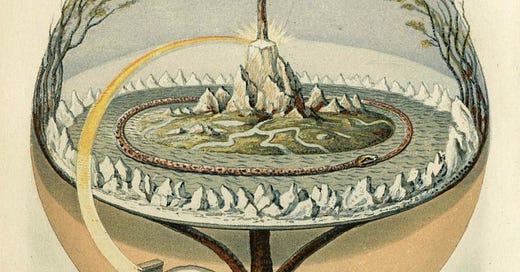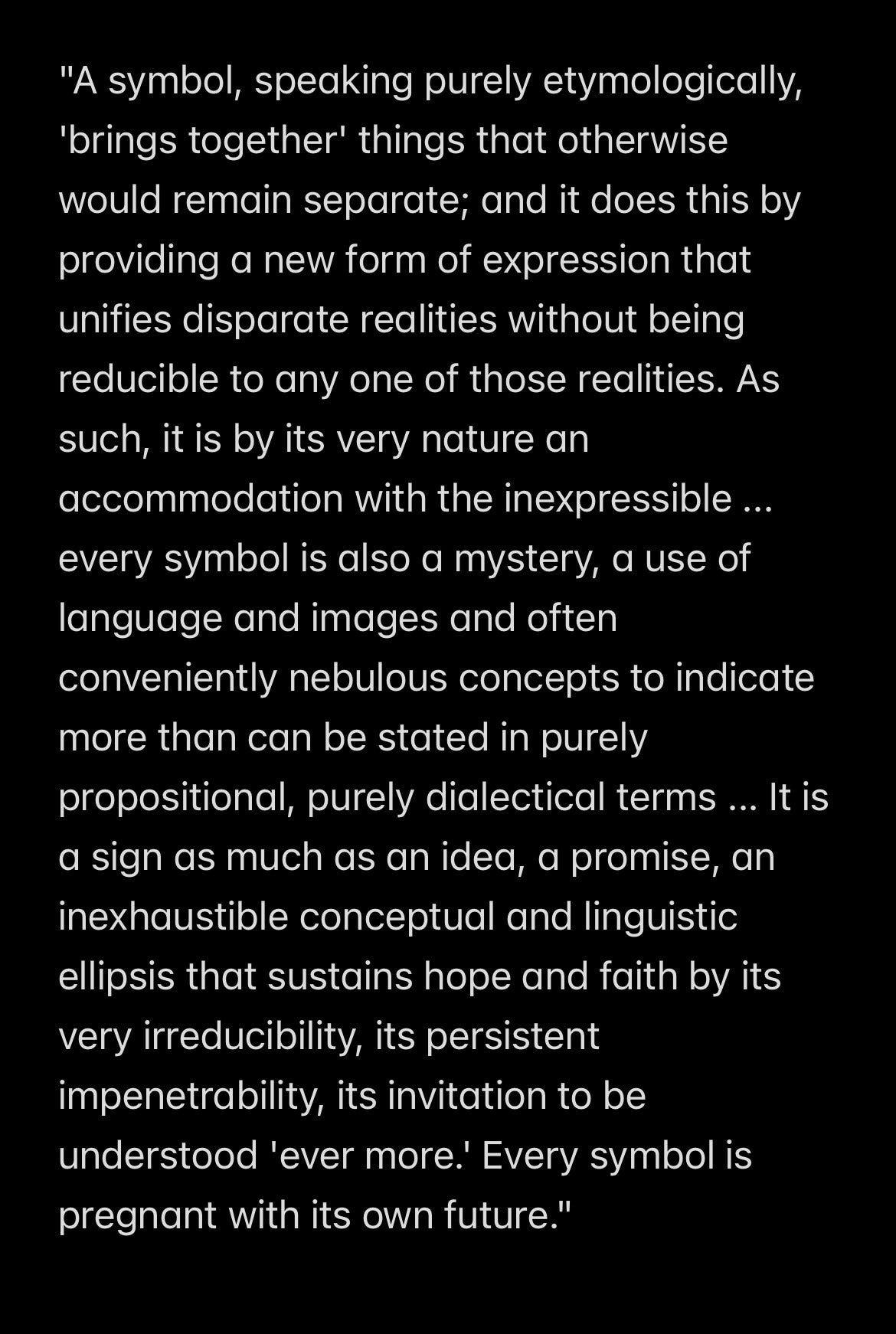The World Tree Is Real
/How heliocentrism and geocentrism are red herrings and everything is a tree/
I have begun a read-through of Matthieu Pageau’s excellent book The Language of Creation: Cosmic Symbolism in Genesis. I will be explicating and reflecting on some of its insights here as I progress through the book. While the book is neatly divided into many bite-sized chapters, by virtue of the nature of the thing it is describing - an ancient, phenomenologically-grounded, fractal onto-cosmology - it does not lend itself to neat division into parts. Everything is very entangled, at least to my mind’s eye. In other words, you will very likely still have questions about what I and Pageau are describing after reading this article. Further articles may help to remedy this. With that said, let us begin.
Modern people have a difficult time understanding the Bible (or really any pre-modern text, for that matter), myself included. This is largely, however, because we have collectively forgotten how to inhabit our own skin. The ancient view of the world was grounded in categories of phenomenal experience - above and below, vertical and horizontal, center and periphery, light and heavy, light and dark, identifiable and unidentifiable, one and many, etc. If I ask you to picture the universe in your mind, it’s more than likely you imagine a black abyss speckled with silver stars with a view from nowhere in particular, or something very much like that. That picture is very far from anything in your own immediate experience. Our picture of the world has been distinctly colored by the advent of technologies like telescopes and microscopes and by historical events in the history of thought like the Copernican Revolution. However, the preceding, Ptolemaic, geocentric model of the cosmos (as much as CS Lewis and I might love it) was already something of a development away from the more ancient model - something Matthieu Pageau calls “dentrocentrism” - a tree-centered cosmology.
Upon my saying this, various associations may occur to your mind. Perhaps Yggdrasil from early medieval Scandinavian cosmology. Perhaps the trees in the Garden of Eden. Perhaps the Porphyrian tree. Perhaps the Kabbalistic tree of life with its sefirot. Perhaps even the Cross of Christ. All of these are relevant associations - but, let us begin to uncover why they are relevant.
The Bible’s cosmology, and ancient cosmology more broadly, involves two poles -Heaven and Earth. This is what God creates in the beginning, with the subsequent days of creation being a marriage ceremony wherein God brings these two poles together in nuptial union - culminating in the birth of a child, a microcosm of this dipolar macrocosm, man. More on that another time. To help us understand what these two cosmological poles are, let us understand there is a hierarchical gradient manifesting these two poles composed of four elements, which Pageau describes as follows:
Light/fire
Air
Water
Earth
These are given to us in reverse order in Genesis 1:2 (Pageau’s translation):
Earth: “The earth was meaningless and confounding”
Water: “Darkness was on the face of the deep”
Air: “The wind of God hovered over the face of the waters”
Light/fire: “God said, “Let there be light”, and there was light.”
We must take these terms the way we actually concretely experience them, phenomenologically, if we are to understand what they meant to ancient people. When Thales said all was water and Heraclitus said all was fire, they did not mean H2O and the oxidation resultant from chemical combustion. We don’t need to debate about ratios of oxygen to nitrogen or consult a soil composition chart. We are talking about categories of meaning here, not material composition, although I don’t wish to at all imply the two are divorced from each other. I just described the union of Heaven and Earth, of meaning and matter, as a nuptial one, after all. Aristotle had four causes for a reason.
If we consider this hierarchical gradient of elements phenomenologically, we can immediately see it is deeply coherent. Obviously light/fire is on top. Light and heat come from above, illuminating and warming what is below. Light makes things intelligible, without light we could not identify anything. Light confers identity, it confers meaning. It names things. Or allows us to name them. As we descend the hierarchy, we reach things that are increasingly corporeal and less and less possessing of light (they are increasingly opaque, rather than translucent). Heavier. Denser. More complex and various. Less simple and unified. We descend with Moses from the radiant splendor atop Sinai towards the amorphous chaos of the swarming people and beasts in the shrouded below. A pyramid is wider at the bottom.
Okay, so where do trees tie into this? Give me a second, I need to add another element to this picture. Another thing we need to recognize is that this cosmological picture is fractal. In other words, the smaller parts of reality have the same structure as the bigger ones, and indeed as reality as a whole. There is a microcosm-macrocosm relationship between the part and the whole. A biblical example of this is the statue from Nebuchadnezzar’s dream in Daniel 2:31-33, which analogically recapitulates the very same hierarchical gradient I have been describing to you:
“This image, which was large and whose brightness was surpassing, stood before you. Its head was of fine gold”
“Its chest and arms were silver”
“Its belly and thighs were brass”
“Its legs were iron, its feet were iron and clay”
The higher portions of the statue are composed of rare, soft, and bright materials, and increasingly less so as you go down the ladder, becoming increasingly common, hard, and dark. From quality to quantity. Nebuchadnezzar’s statue is a microcosm of the structure of the cosmos at large. However, this is the case of absolutely anything you perceive in the world, to one degree or another. Every thing you can see has an identity, its unity, and its components, its multiplicity. Some of the components will be more central to the identity in question than others. If the handle breaks off my coffee mug, I can still perhaps use it as a coffee mug, with some impaired function. If the coffee mug falls to the ground and shatters, I no longer have a coffee mug. Identity and components. Unity and multiplicity. Center and periphery.
This is exactly where trees come into the picture. Trees are quintessential microcosms of reality as a whole, both in the vertical and horizontal dimensions. Vertically, trees span the horizon line, up from the dark, moist soil, up through the air, towards the heavenly light which makes the world intelligible. Horizontally, trees move out from an axis of unity, their trunks (which are usually straighter than their branches, more at-one), towards a world of fractal multiplicity, their branches (which are usually more curved and crooked than their trunks, less at-one). Trees bridge worlds. The world is a tree, binding together all of the disparate elements present into an over-arching, fractal pattern. A unified identity. The World Tree is real.
Endnotes:
https://orthodoxartsjournal.org/most-of-the-time-the-earth-is-flat/









The world is a tree. Christ is a tree. Christ is the life of the world.
There is so much said in here that reflects my personal ideas almost 1:1 it's uncanny. I've spent the last year really focusing on building an ontological framework, and have come to one that I choose to represent as a fractal. I believe it's a symbol for the same spirit as yin/balance/yang, father/spirit/son, Brahma/Vishnu/Shiva, etc... although I like simplicity/dialectic/complexity or unity/seperation/individualisation. Even an attempt to re-unify by uniting a seperation creates a seperation between unity and seperation, reinstating the state of seperation/ego, an attempt to act perfect also creates good/bad outcomes.
The only way to break free from our inevitable actions of perpetual seperation, is to act towards unity through sacrifice, forgiveness, love, or as I think captures the essence best: faith
Loved this, great article and very validating after just recently coming to this conclusion